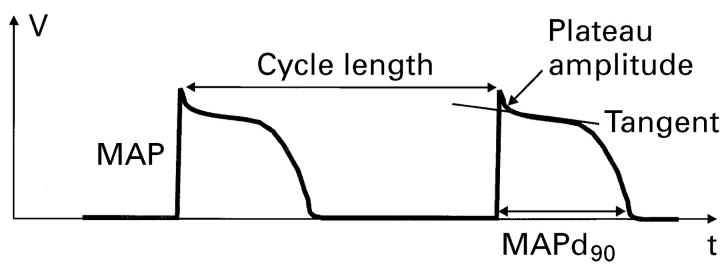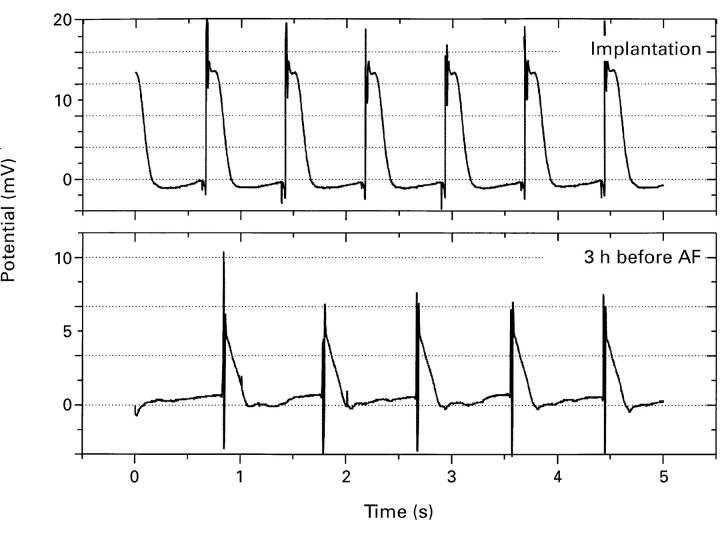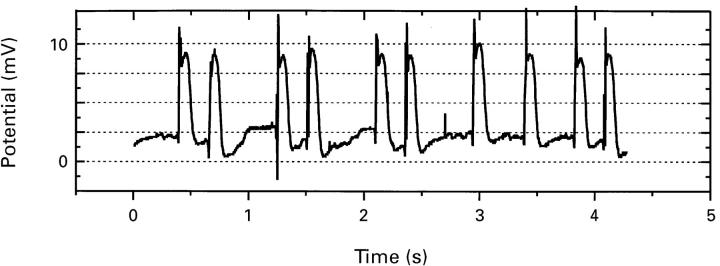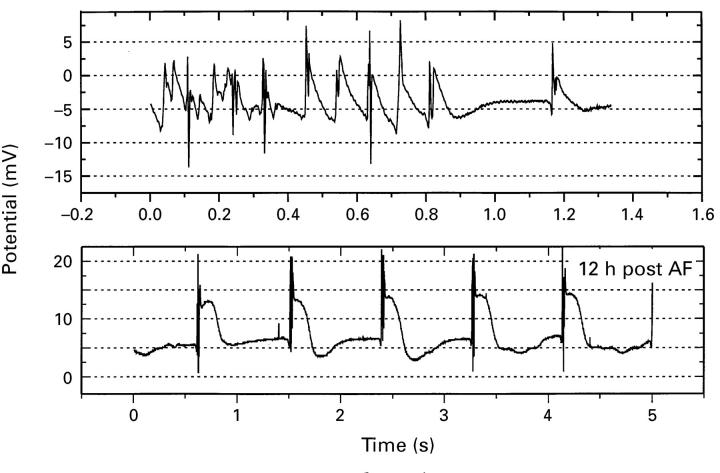Abstract
Objective—To show that the monophasic action potential (MAP) recorded continuously from human epicardium may be used to predict the imminent onset of atrial fibrillation or flutter (AF) following surgery, thus allowing prophylactic treatment to be started. Patients—22 patients (14 male, 8 female; mean (SD) age 64 (12) years) undergoing aortic valve replacement. Setting—Tertiary referral centre. Methods—Over a mean observation period of 8 (2.7) days (range 4 to 14), nine episodes of AF were seen in six patients. Before AF, specific and significant alterations of the MAP morphology were observed. In seven of nine episodes the MAP shortened (25 (4)% 60 minutes before AF), developed a triangular shape, and the plateau amplitude decreased from 5.3 (1.2) to 2 (0.2) mV. In the two remaining episodes the beat to beat variability of cycle length and MAP duration at 90% repolarisation (MAPd90) increased significantly from 24 (7) ms and 12 (8) ms (24 hours before AF) to 137 (27) ms and 56 (11) ms (30 minutes before AF) respectively. AF was successfully treated by the administration of sotalol in three cases and by a combination of verapamil and digoxin in a further four. Previously observed changes of MAPd90 and MAP morphology regressed after conversion to sinus rhythm. Conclusions—The continuous and intermediate term recording of the MAP from atrial epicardium appears to be a valid tool for detecting imminent AF after cardiac surgery with a high sensitivity (99%) and specificity (88%). Optimised antiarrhythmic treatment may thus be given selectively for prophylaxis. Keywords: postoperative atrial fibrillation; monophasic action potential; postoperative management; prophylactic antiarrhythmic treatment; arrhythmias
Full Text
The Full Text of this article is available as a PDF (163.2 KB).
Figure 1 .
Atrial monophasic action potential (MAP) parameters analysed using the semiautomatic evaluation program. MAPd90 = MAP at 90% repolarisation.
Figure 2 .
Atrial monophasic action potential before the onset of atrial fibrillation (AF).
Figure 3 .
Changes in cycle length and monophasic action potential (MAP) duration variability and their linear correlation with the time interval before the onset of atrial fibrillation or flutter (AF). Error bars = SD. ΔCL, cycle length variability, ΔMAPd90, variability of monophasic action potential duration at 90% repolarisation.
Figure 4 .
Atrial monophasic action potential morphology before atrial fibrillation.
Figure 5 .
Atrial monophasic action potential morphology after the conversion of atrial fibrillation to sinus rhythm.
Selected References
These references are in PubMed. This may not be the complete list of references from this article.
- Allessie M. A., Kirchhof C. J., Konings K. T. Unravelling the electrical mysteries of atrial fibrillation. Eur Heart J. 1996 Jul;17 (Suppl 100):2–9. doi: 10.1093/eurheartj/17.suppl_c.2. [DOI] [PubMed] [Google Scholar]
- Antzelevitch C., Sicouri S., Litovsky S. H., Lukas A., Krishnan S. C., Di Diego J. M., Gintant G. A., Liu D. W. Heterogeneity within the ventricular wall. Electrophysiology and pharmacology of epicardial, endocardial, and M cells. Circ Res. 1991 Dec;69(6):1427–1449. doi: 10.1161/01.res.69.6.1427. [DOI] [PubMed] [Google Scholar]
- Aranki S. F., Shaw D. P., Adams D. H., Rizzo R. J., Couper G. S., VanderVliet M., Collins J. J., Jr, Cohn L. H., Burstin H. R. Predictors of atrial fibrillation after coronary artery surgery. Current trends and impact on hospital resources. Circulation. 1996 Aug 1;94(3):390–397. doi: 10.1161/01.cir.94.3.390. [DOI] [PubMed] [Google Scholar]
- Bolz A., Hubmann M., Hardt R., Riedmüller J., Schaldach M. Low polarization pacing lead for detecting the ventricular-evoked response. Med Prog Technol. 1993;19(3):129–137. [PubMed] [Google Scholar]
- Creswell L. L., Schuessler R. B., Rosenbloom M., Cox J. L. Hazards of postoperative atrial arrhythmias. Ann Thorac Surg. 1993 Sep;56(3):539–549. doi: 10.1016/0003-4975(93)90894-n. [DOI] [PubMed] [Google Scholar]
- Franz M. R. Bridging the gap between basic and clinical electrophysiology: what can be learned from monophasic action potential recordings? J Cardiovasc Electrophysiol. 1994 Aug;5(8):699–710. doi: 10.1111/j.1540-8167.1994.tb01192.x. [DOI] [PubMed] [Google Scholar]
- Franz M. R. Method and theory of monophasic action potential recording. Prog Cardiovasc Dis. 1991 May-Jun;33(6):347–368. doi: 10.1016/0033-0620(91)90002-4. [DOI] [PubMed] [Google Scholar]
- Janse M. J., Kléber A. G. Electrophysiological changes and ventricular arrhythmias in the early phase of regional myocardial ischemia. Circ Res. 1981 Nov;49(5):1069–1081. doi: 10.1161/01.res.49.5.1069. [DOI] [PubMed] [Google Scholar]
- John R. M., Taggart P. I., Sutton P. M., Costa D. C., Ell P. J., Swanton H. Endocardial monophasic action potential recordings for the detection of myocardial ischemia in man: a study using atrial pacing stress and myocardial perfusion scintigraphy. Am Heart J. 1991 Dec;122(6):1599–1609. doi: 10.1016/0002-8703(91)90277-o. [DOI] [PubMed] [Google Scholar]
- Konings K. T., Kirchhof C. J., Smeets J. R., Wellens H. J., Penn O. C., Allessie M. A. High-density mapping of electrically induced atrial fibrillation in humans. Circulation. 1994 Apr;89(4):1665–1680. doi: 10.1161/01.cir.89.4.1665. [DOI] [PubMed] [Google Scholar]
- Stafford P. J., Kolvekar S., Cooper J., Fothergill J., Schlindwein F., deBono D. P., Spyt T. J., Garratt C. J. Signal averaged P wave compared with standard electrocardiography or echocardiography for prediction of atrial fibrillation after coronary bypass grafting. Heart. 1997 May;77(5):417–422. doi: 10.1136/hrt.77.5.417. [DOI] [PMC free article] [PubMed] [Google Scholar]
- Yuan S., Blomström-Lundqvist C., Olsson S. B. Monophasic action potentials: concepts to practical applications. J Cardiovasc Electrophysiol. 1994 Mar;5(3):287–308. doi: 10.1111/j.1540-8167.1994.tb01165.x. [DOI] [PubMed] [Google Scholar]
- Zaman A. G., Alamgir F., Richens T., Williams R., Rothman M. T., Mills P. G. The role of signal averaged P wave duration and serum magnesium as a combined predictor of atrial fibrillation after elective coronary artery bypass surgery. Heart. 1997 Jun;77(6):527–531. doi: 10.1136/hrt.77.6.527. [DOI] [PMC free article] [PubMed] [Google Scholar]
- ten Eick R. E., Whalley D. W., Rasmussen H. H. Connections: heart disease, cellular electrophysiology, and ion channels. FASEB J. 1992 May;6(8):2568–2580. doi: 10.1096/fasebj.6.8.1375569. [DOI] [PubMed] [Google Scholar]







